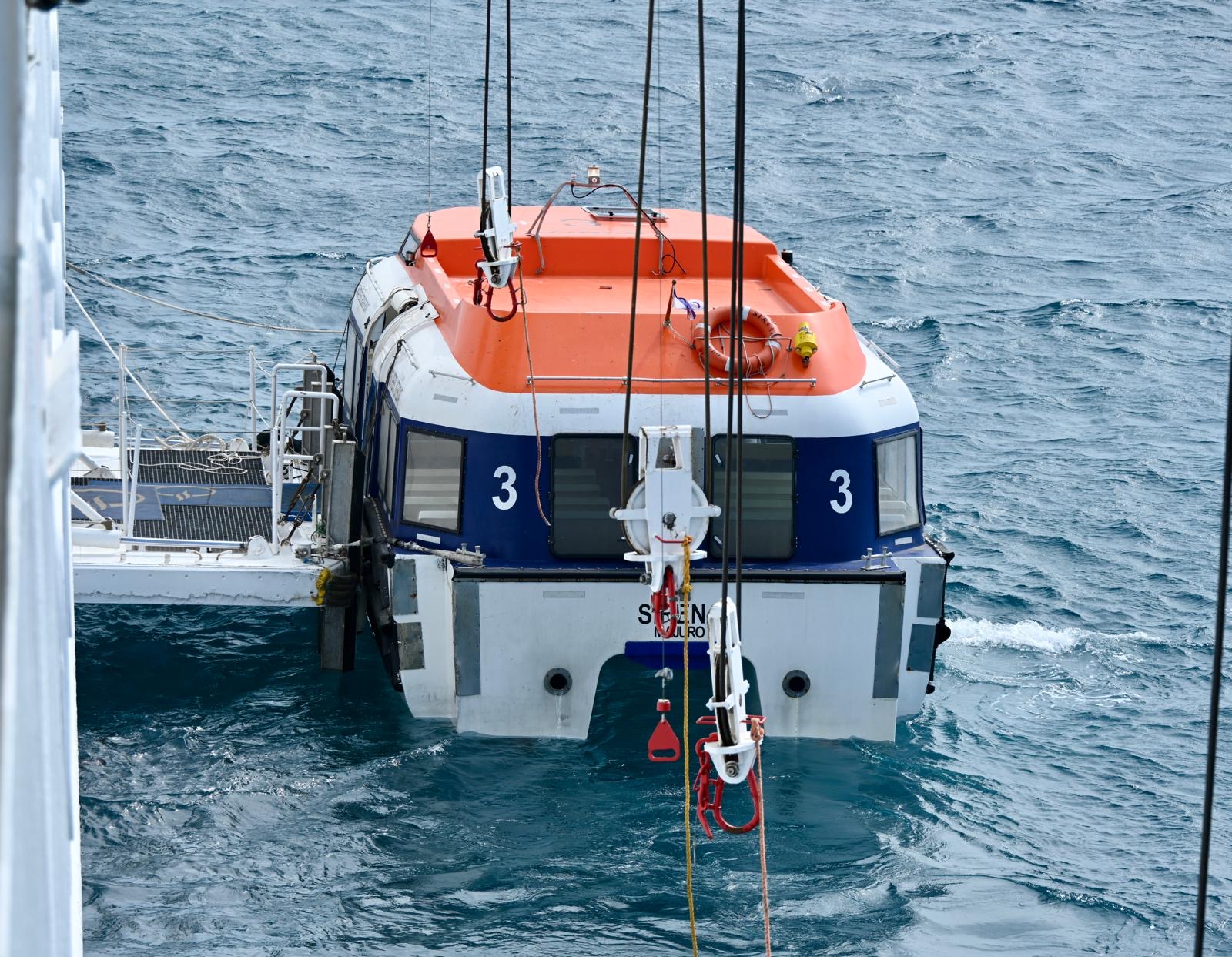First of all, thank you for all your comments. It is always lovely to hear from you.
Friday 21 November 2025 – Sekondi-Takoradi, Ghana: Sylvia
We arrived in the twin cities of Sekondi-Takoradi, the capital of the Western Region of Ghana, at about 9am this morning. Several brightly coloured fishing boats were returning to shore after their night’s fishing.



It didn’t take long to be cleared to disembark and by 9:30am we had been met by Solomon, our guide for the day, and were comfortably settled in a Toyota SUV, ably driven by Benjamin. It was a refreshing change from the chaos in Abidjan yesterday with Solomon waiting right at the bottom of the gangway and numerous vendors set up along the wharf.

We headed out of Takoradi Harbour, the oldest of the two ports in Ghana, having been established between 1920 and 28. The second harbour is near Akra. About one-million of the 35-million total population of Ghana live in these twin cities. Huge reels of undersea cables were stacked up along the port as we left.

Ghana achieved independence from the British on 6 March 1957 after a brief period of struggle. The Portuguese were the first Europeans to arrive in 1471. They were followed by the Danes, Dutch, Swiss and then English, who ruled from the 1800’s. Prior to independence it was known as the Gold Coast. Ghana is still the largest supplier of gold in Africa but do not refine here. The country is also known for cocoa, oil and timber. The country has had its share of coups but is now much more stable with the fourth republic in place since 1992. It is a democracy with presidents limited to two four-year terms.
It seems to be quite a tolerant society with 70% Christian and 25% Muslim, as well as more than 50 different ethnic groups. Apparently there is lots of intermarriage both between tribes and religions.
Once out of the port we saw several large schools. Education is free to age 18 and the country boasts 70% literacy and numeracy. Even though 24% of the population live below the poverty line the country feels much more organised than the Côte d’Ivoire. There are still lots of traditional market places and small villages but we felt less sense of chaos.
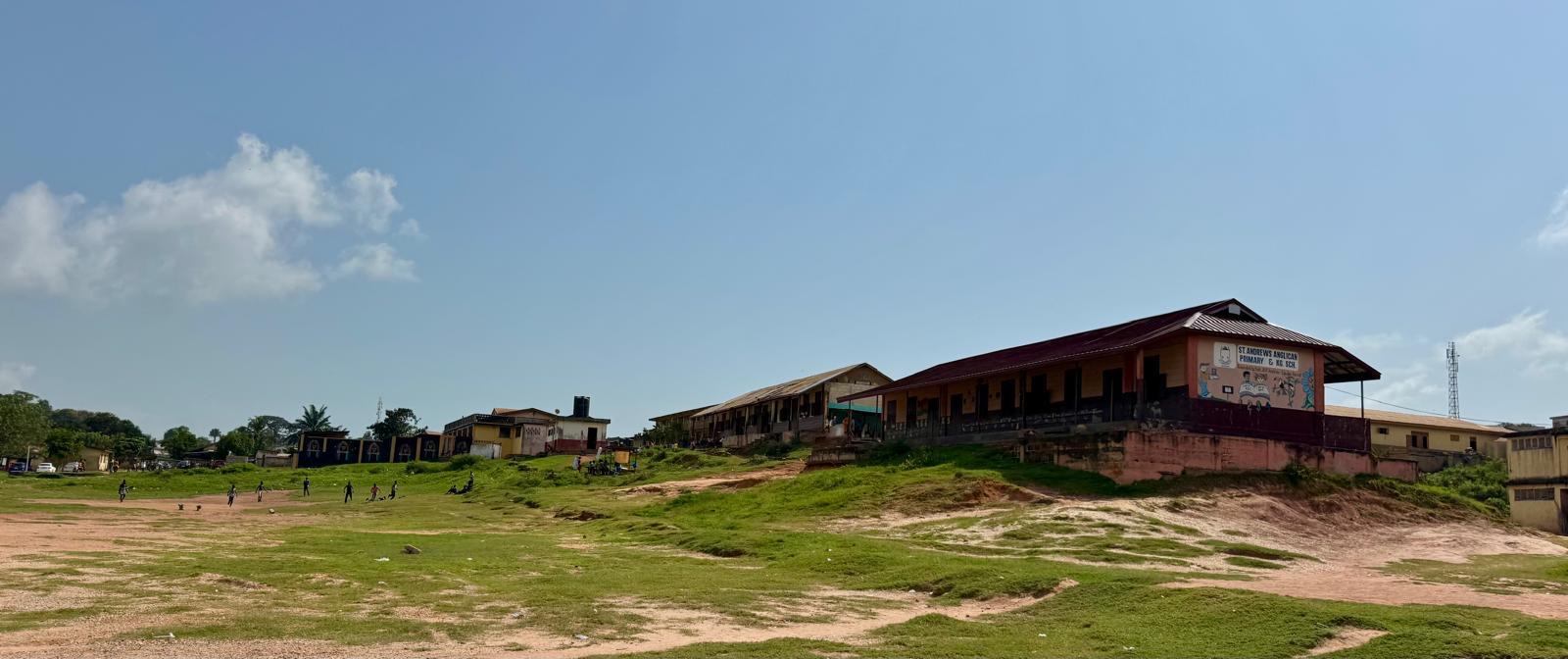
We had been driving through town for about 20-minutes when four coach-loads on Oceania-organised tours raced past us with their police escort. We tucked in behind – apparently this is allowed as we are also from the cruise. We weaved in and out of the traffic making great time on the crowded roads. It seems they only get one cruise ship in every week or two, and only for a few months of the year so I guess the locals accept the inconvenience. We are apparently on the last ship for this year.
We drove past multiple local market areas bustling with people and with lots of plantains, cassava, pineapples, mangoes, watermelon and other fruits and vegetables on display. Sheep, goats and chickens wandered about freely. Straight-backed women, men and even children carried all sorts of loads on their heads. Some looked very heavy. Women stood at the side of the road with big basins of cold drinks, plantain chips and other snack foods on their heads trying to sell them to passing motorists.







We also passed numerous police and customs checkpoints and were even stopped at one for a random license, insurance and registration check. The roads must be a bit treacherous as we passed two burned out trucks at different points. Just in case the many pot-holes are not enough to keep the traffic to a reasonable speed, there are also many judder bars so it was a fairly bumpy trip.

After about 75-minutes we turned off from the main road and lost our police escort. The coaches were heading on to one of the old slave-trade castles a little further up the coast. A bit later we came to a massive high-security prison structure, complete with guard training school. There was also a psychiatric hospital and a leprosy hospital in the same general vicinity.
Just on noon, we arrived at Kakum National Park, ~325 square kilometres of pristine rainforest. It is home to a number of animals and hundreds of butterfly species. It also boasts a 350m canopy walk with eight canopy bridges 12-40m high strung between wooden platforms high in the trees. This is what we had come for and we quickly headed off, walking up a fairly steep track to get to the canopy. This attraction draws people from all over and we passed several school groups and other visitors. We were lucky though and had the walk itself pretty much to ourselves, and a small group of maintenance workers. It was a truly impressive experience with the trees towering above us. Unfortunately, given all the visitors, one rarely sees animals in this part of the park, although we did see a few lizards, several brightly coloured butterflies and thousands of red soldier ants, which we were careful to avoid.






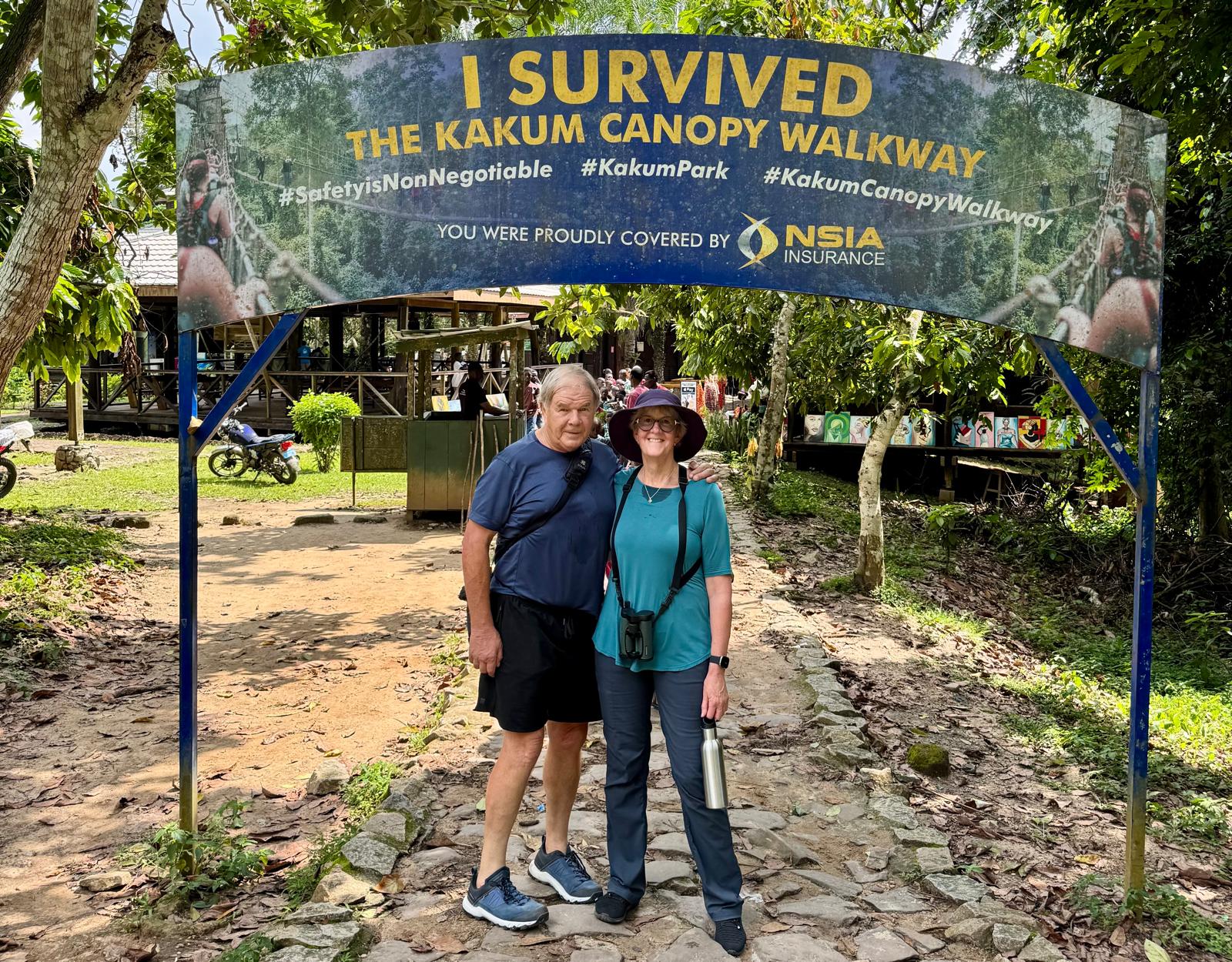
We were on a tight timetable for the day so after the canopy walk, quickly got back in the car to head to our next stop, Cape Coast Castle, another relic from the slave trade era. This castle is one of about 60 forts and castles in Africa dating back to colonial times, 40% of which are in Ghana. This one was built by the British in 1664 and was another of the last points of exit for slaves. We were introduced to Gloria, one of the site guides, who gave us a very informative tour, apparently the quickest she had ever done.



She was very open about how the local populations were complicit in the slave trade, gathering up slaves from competing tribes and walking them, often thousands of kms in bare feet, to these slave trading centres, from where they would be shipped to the Americas. There was a memorial plaque on the building that was a joint apology from the tribes made in the 90’s.

We visited the dungeon areas where 150-200 men were held in each of the 5 small chambers for 2-3 months waiting for shipment. There was only a small gutter around the edge of the room for them to use as a toilet. When it rained the waste would be washed through the other rooms and out to sea but it was clear that this would overflow and that conditions in general were absolutely squalid. The women’s quarters were no better but there were only two chambers rather than 5. Eventually the men would be herded through a tunnel towards the women’s quarters and then together through the door of no return and out to sea.





A few years ago the remains of some slaves were repatriated to the country and the outside of the door is now labeled as the door of return. Once again a very sobering visit. Like many military sites the intention is that these places serve as a reminder of the atrocities to ensure we don’t ever repeat them.
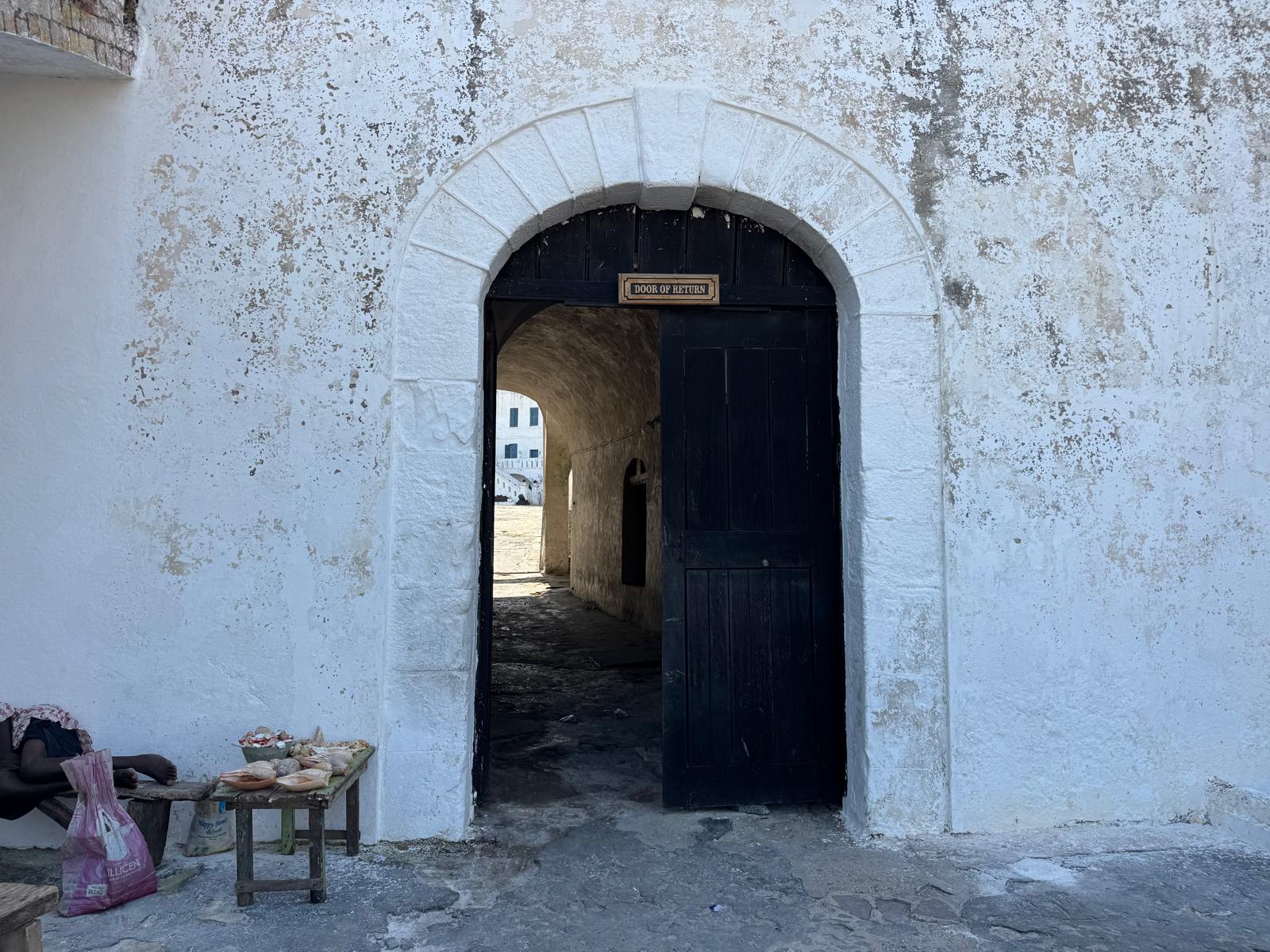
We headed back towards the Sirena. I was struck by the many funeral notices displayed on large posters and small billboards in many areas. Apparently this is standard practice. Bodies are held in the mortuary for a number of months until everyone gets together for a funeral, which generally lasts from Friday to Sunday to commemorate and mourn.
We arrived back at the port in good time, with special thanks to Benjamin for his fantastic driving. I had used Hausa Tours to make all the arrangements for today and I would definitely use them again in the future. They were fantastic.

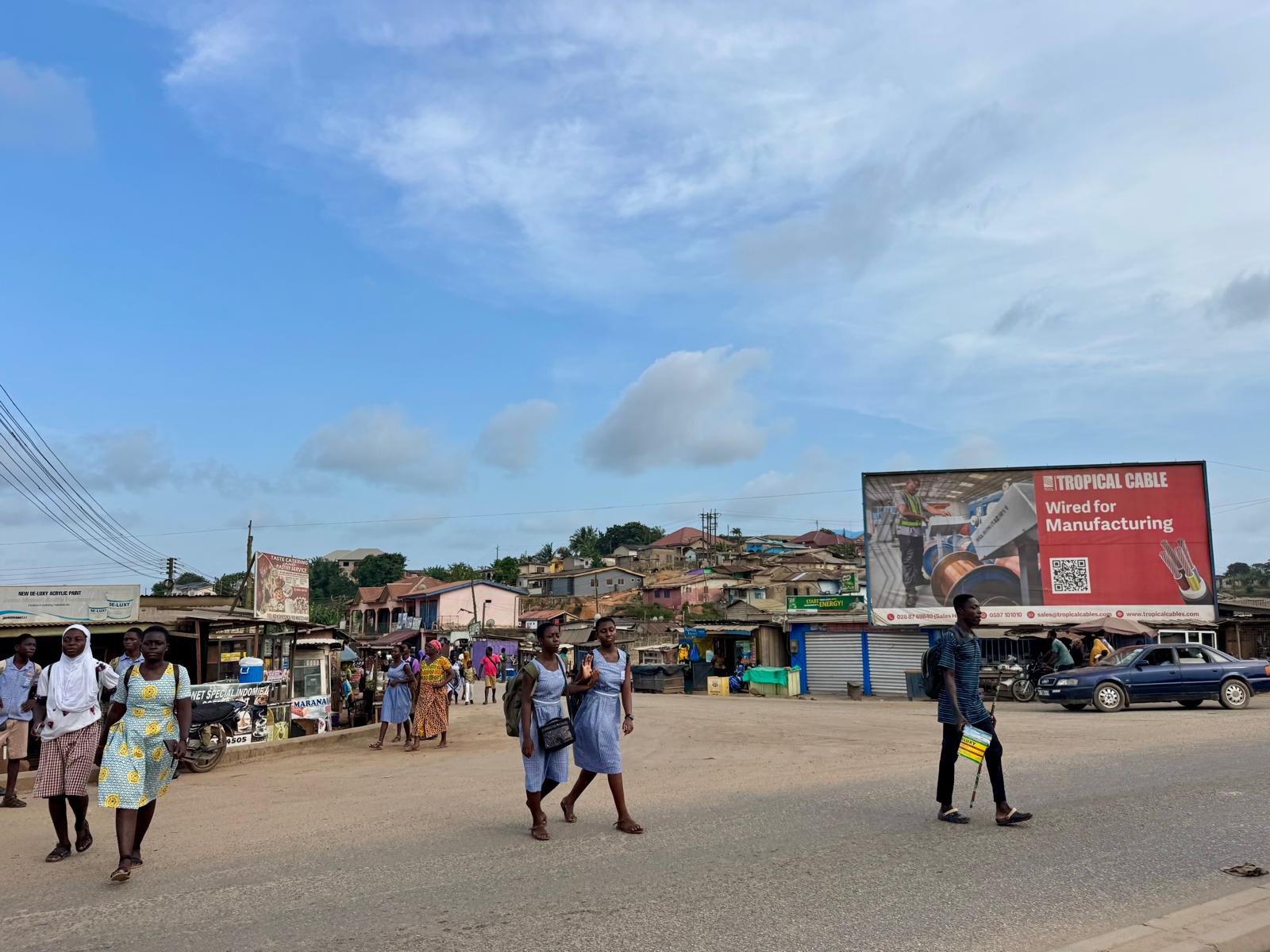


Saturday 22 November 2025 – Lomé, Togo: Roger
As we steamed into the very tidy looking port, there were once again numerous ships anchored off the coast, no doubt waiting for access to the port, which is situated less than 10kms east of the Ghana border.

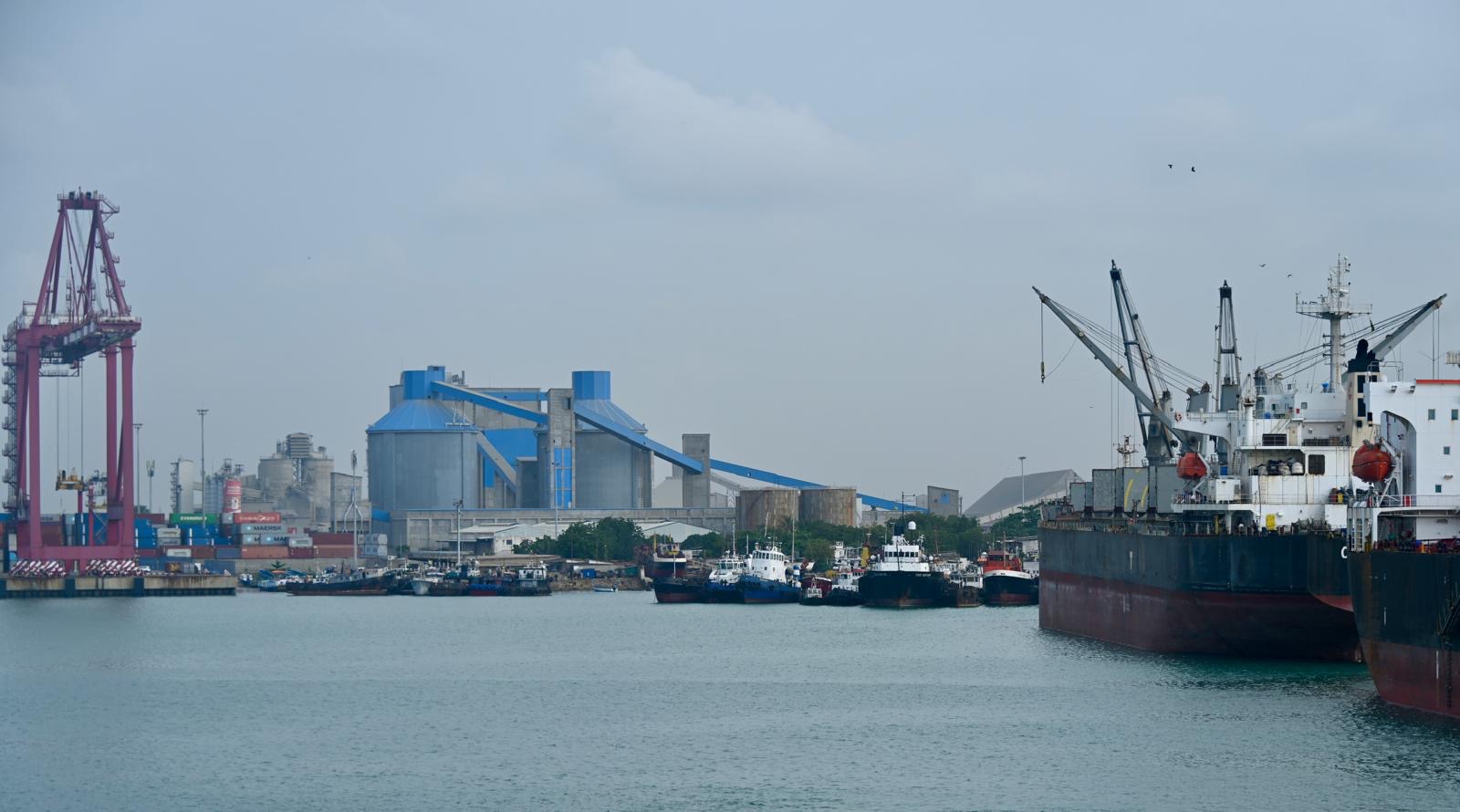
Walking off the ship this morning we were greeted by a rather active local grass band, which included a couple of guys on tall stilts.


Togo, originally settled by the Portuguese, was taken over by the Germans in the 1800’s. After WWI it was divided up, with the French on the west and the British on the east half. In the late 1950’s it gained independence. Now it has a population of around 9 million, about 40% of whom live below the poverty line despite a GDP growth of over 6% in 2023.
Today we were on a ship’s tour as Sylvia couldn’t find a local guide she trusted. Mounting a 60-seater bus we headed out in convoy with another bus, a police motorcycle leading the way, and a van load of police and an ambulance following along behind us. After driving through what appeared to be the tidiest port area we have seen in west Africa, we did a right turn east onto the best road by far that we have seen in this part of the world. With two lanes in each direction and street lights along the medium there were no pot holes. We sped along at up to 80kph, the police escort ensuring all traffic stopped for us and moved over so we could speed past. Lots of tuk-tuks and motorcycles were about, just like the rest of West Africa. Everything along the way was quite tidy with the normal roadside stalls but little evidence of the red dust.

Soon we turned down a dirt road, which lead to one of the king’s palaces. There are three kings in Togo, each responsible for a different part of the country. The palace was by no means grand. As we dismounted the bus, some cute kids raced out to greet us with smiles from their mother in the doorway.

There was a brief ceremony to welcome us, where a bottle of gin was decanted into a glass then tipped on the ground, followed by a vessel of water mixed with cornflour. We were seated in the hall with a concrete roof and no walls while speeches were given on how the system of kings works in Togo. Eventually the chief was escorted down a ramp, shaded by an umbrella. More speeches followed explaining how Queen Victoria had presented the country a staff commemorating the abolishment of slavery. This area had been a centre for the slave trade, primarily under the Portuguese.



The king never said a word. At the end of the speeches we were invited to get our photos taken with him. I found him quite a friendly chap, whose face lit up when I said I was from NZ.

Back on the buses, we headed a short distance back to the main road, went west then turned onto another dirt road towards the beach where we drove east, again passing numerous beachside restaurants. We stopped to observe a large number of fishermen and their boats that had returned from the 2am net setting expedition. Lots of woman sat around filleting small fish.


Turning around we headed back along the beach to a fish-smoking house. The catch is mainly sardines and anchovies. Other very small fish were laid out on the sand beside the road to dry in the sun before being mixed with other food and cooked.






At the next stop along the beach we saw dozens of people pulling in a huge net. Of course a few of us jumped in and gave a hand. They were pulling in both ends of the net which was hundreds of meters long. Being a Saturday the kids were off school, the older ones also giving a hand along with the mums, some with babies on their back. They were still pulling when the whistle went and it was back on the bus for us as dozens of kids, too young to help with the net, gathered in a field to watch us with amusement.





Next we headed to Lake Togo, a large fresh water lake with fish farms, from which they harvest fresh water tilapia, shrimp, catfish and crabs. There we had a buffet lunch including goat meat, chicken and fish at Hotel Le Lac, a resort with jet skis and other water toys.


After heading east again on the highway for about thirty kilometres we turned off and headed north through a village famous for its cheap petrol that is stolen in Nigeria and smuggled down through Benin then by canoe into Togo, where it is sold in bottles by the roadside. The border with Benin is only about 5kms from here.

Back on dusty roads we eventually arrived at what we were told was a forest. It turned out to be a group of buildings on the edge of a forest. We dismounted and gathered around a statue figure. As the guide stated speaking an altercation took place as one of the locals tried to remove the guides boom box that her microphone was routed through.
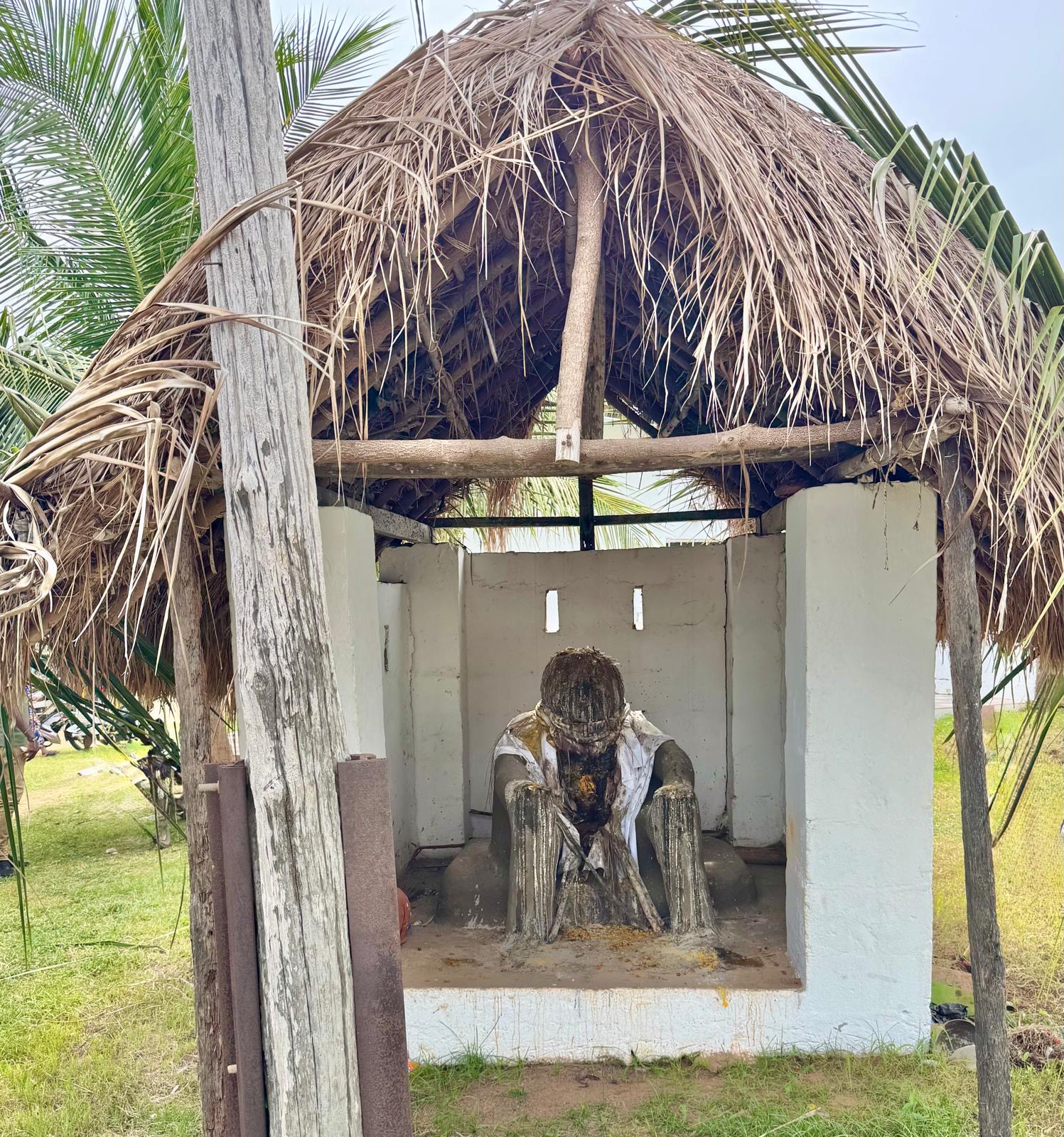
This place is sacred as people from Ghana came here hundreds of years ago and brought some stone with them, which is hidden in the forest and brought out for ceremonies. There are little sculptures along the track leading to the stadium. (This is all part of the voodoo religion)


We were eventually led through an arch with an eye painted on it to a waiting group dressed in white sheets. They were behind a line which I think defined the entrance to the forest, which we were not allowed to cross. A gin and muddy water ceremony was conducted, I thought this would give us access to the forest but that was not the case. Ceremony over, it was back on the bus for another dusty road drive to a different village.



Here, the whole village turned out, including the local band beating drums and various metal items capable of making noise. Suddenly a large grass object came spinning and gliding down the path towards us. Another gin and muddy water ceremony was preformed after which we were lead down the path and seated in the shade of some large trees while the band played and several of the colourful grass objects danced around, one splitting into 4 smaller versions, which continued dancing around. Every now and then they would lift one up and a small strange object would come out and move or shake. They even tipped one of the big ones over so we could believe no one was inside. Many of the local villagers were dancing and working themselves into a trance. This is all voodoo stuff. Apparently as they didn’t have weapons to fight with the story goes that the warriors would change their shape into different objects to defeat their foe. The local children all gathered around us to watch the spectacle.









The drive back was quite quick as traffic was once again pushed aside for us to pass through.
There are large fields along the way, many with irrigation and lots of people manually tending their crops. There must have been a great concrete block salesman here in the past as many properties have high concrete block fences around them. According to one of the guides this was to stop people from stealing the land. There were also some really nicely decorated walls in places made of tiles.



It was just after 1630 when we arrived back at the boat, putting to sea at 1730 for the next leg of the journey.
Sunday 23 November 2025 – At Sea: Sylvia
It was another quiet day at sea today with all the usual activities. Bridge lessons continued for me again as well as lots of gym sessions and walking around the deck. Roger enjoyed a massage this morning. We also attended a talk about São Tomé and Principe, where we will be tomorrow. Afternoon tea today was a special cheesecake afternoon tea with many different varieties of cheesecake on offer. They certainly do this sort of thing well.


At 5:30pm Roger attended a cocktail party for Oceania Club members (I was at a HIIT session in the gym). He wasn’t overly impressed. A lovely sunset rounded out the day.

Monday 24 November 2025 -Sao Tome: Roger


São Tomé and Principe were discovered as an unoccupied archipelago by the Portuguese in 1470. Later that century it was occupied and colonised by the Portuguese. With very fertile soil it was ideal for growing sugarcane and slaves were bought in from Angola and nearby countries in Africa as cheap labour. Some were also exported on to the Americas. It became a large sugar producer until harsh conditions on the plantations led to slave revolts, including the one led by Rei Amado in 1595, who briefly ruled the island before he was captured and executed. In the 19th century, coffee and cocoa were introduced, and the rich volcanic soils proved ideal for their cultivation. By 1908, the islands had become the world’s largest producer of cocoa. Following a military coup in Portugal in 1974, the Portuguese government recognized the islands’ right to independence, which was gained in 1975.

Yesterday afternoon we went to a session about Sao Tome called ‘Culture and Heart; Nature in Harmony’ with Chris McPherson. This is something the boat puts on prior to visiting each port. Reading from a computer screen in conjunction with slides, McPherson is a little hard to listen to. However, he painted a rather magnificent picture of Sao Tome. With it’s magnificent waterfall, volcanic plug national parks, and a rather luxurious looking coffee and cocoa plantation our expectations were quite high.
This is the only port on the trip where we anchored offshore and had to take a tender into the wharf. It was just after 7:30 when we boarded the tender for the short ride to what looked, from a distance, like quite a picturesque Island . It was around 8am when we landed. We were met by Sipson, who Sylvia had communicated with to organise the trip. The impression that she had was this guy was going to be our guide because we were the first to book and we were going on the best trip, highly recommended by him. That was not the case as we were introduced to our driver-guide Fred. We piled into a rather old Honda and headed into the town.
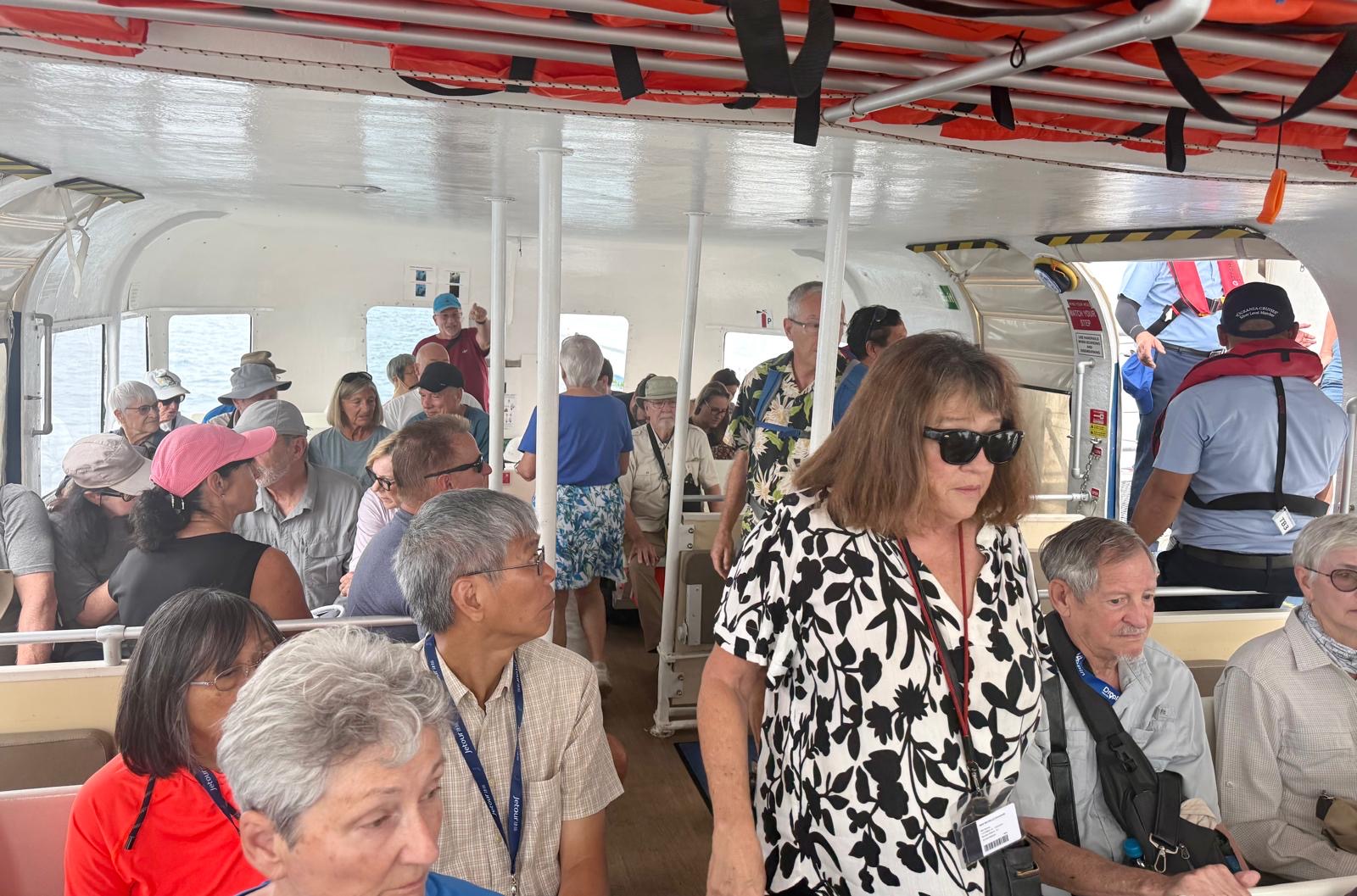
We stopped outside the church opposite the palace, both well kept and recently painted. It was at this point we quickly worked out that Fred didn’t really speak a word of English – well maybe the odd word, but he certainly didn’t understand many.


Off we went, heading south on EN2. There were a few roadside shops and the odd stall. There certainly hasn’t been a paint salesperson here probably since independence. The houses are mostly pretty rough, most with walls dividing the properties, many made of rusting corrugated iron.




We stopped at the first river, where women were washing clothes. This became a common sight at just about every river we passed. Often the clothes were laid out along the roadside on grassy berms to dry. Sometimes they were even laid out on the edge of the road. We even spotted a car getting washed in a local river.

The other task women seem to be responsible for is collecting water at local water points, some on the roadside, others in the village. It became quite common to see a woman with a 10-litre container on her head. The other task that required a walk was dishwashing. Women and older children carrying all the dishes in a large bowl on their heads was another common sight.


Now you’re probably thinking ‘what do the men do?’ Well it appears – not too much. Many young men tended to be sitting around in groups talking or looking at their phones. Some older ones were cutting the grass on the side of the road with a machete, others carrying loads of wood on their heads.

Our first proper stop was at Agua Ize, once a cocoa processing town. We parked beside a large run-down building. Apparently there is an information centre there that goes through the cocoa making process. Eventually Fred managed to communicate to us, after Sylvia threw her hands up in the air in a disbelief gesture (frustrated at trying to communicate), that the place was closed today. There were many dilapidated, large, concrete dorm-type buildings there with narrow gauge railway tracks running between some of them. It must have been quite a grand setup in its day.



We drove a short distance up a hill and pulled up outside what was once a large, rather grand hospital. A barefoot and rather pregnant woman came running out and insisted on showing us around. Leading us inside she pointed out where various things used to be, such as the infirmary and maternity wards etc. People now live in what’s left of the place, we presume squatting there.


We went up the once grand staircase to the top floor. From there we could see, not far up the hill, the original hospital built in 1914, this one having been built in 1928. All the roofing material on most of the buildings has long gone and now the steel rafters are rusting away. Jessica, the barefoot lady, pointed out her garden running off the ground floor, where she and her six-soon-to-be-seven children live. In spite of her ragged dress and seldom washed hair she appeared happy and proud of her place.


We continued heading south around the coast, stopping at Boco do Inferno (Mouth of Hell), a low cliff top where there are some interesting lava formations, along with a few stalls selling souvenirs. The water rushes in and spews out of holes in the lava. It must be quite impressive during storms but was not too spectacular today.



We stopped and checked out coffee and cocoa bean trees growing on the side of the road, then wound our way further along the road, often crossing to the other side to go around potholes. The gears grated as Fred, not the most skilled driver we have come across, tried to change down to get the under-powered Honda up the hills.
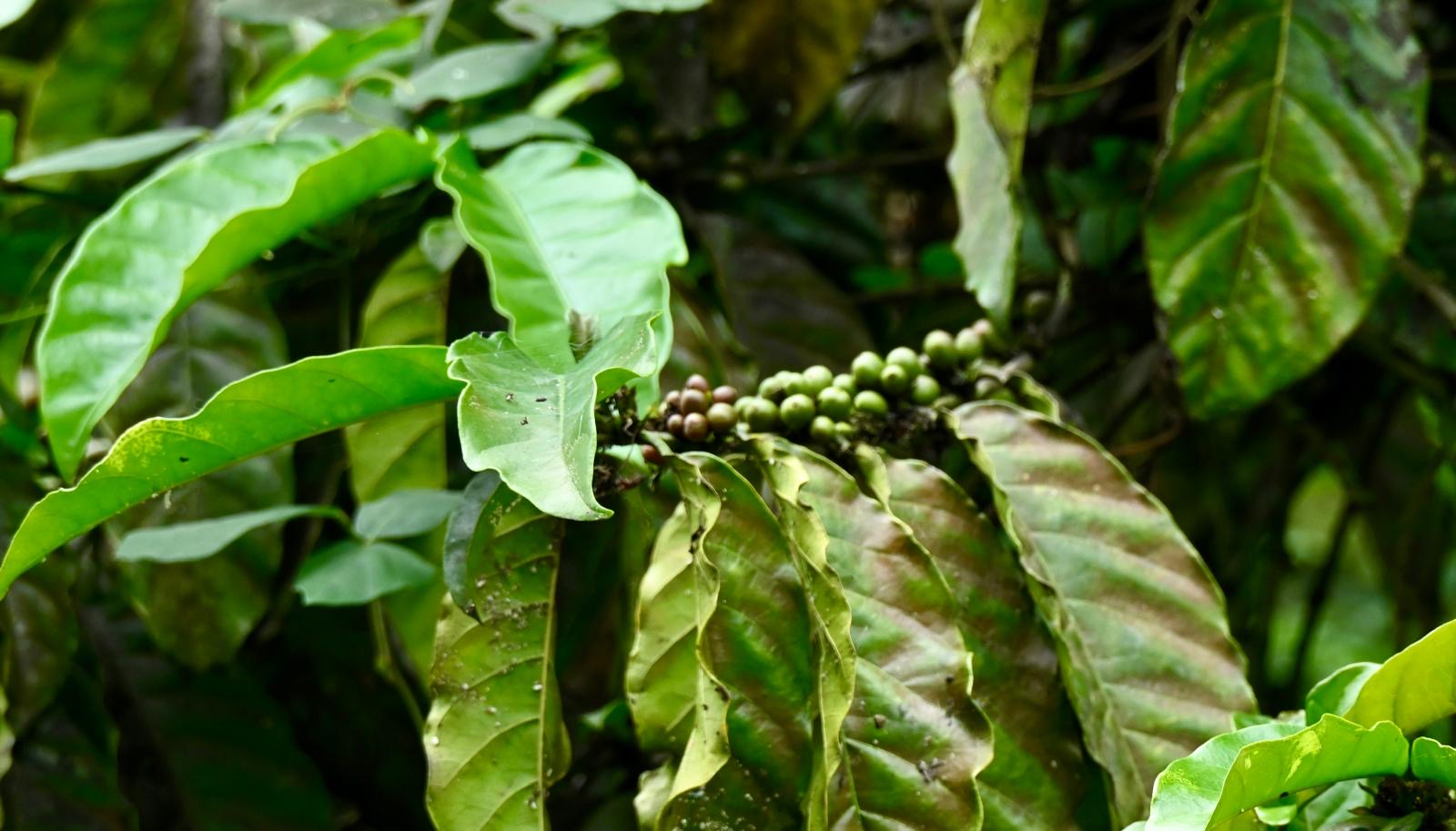

Next we stopped at a beach. A short walk revealed a failed restaurant overlooking a nice beach, where a man showed off his prized catch of two miniature fish.

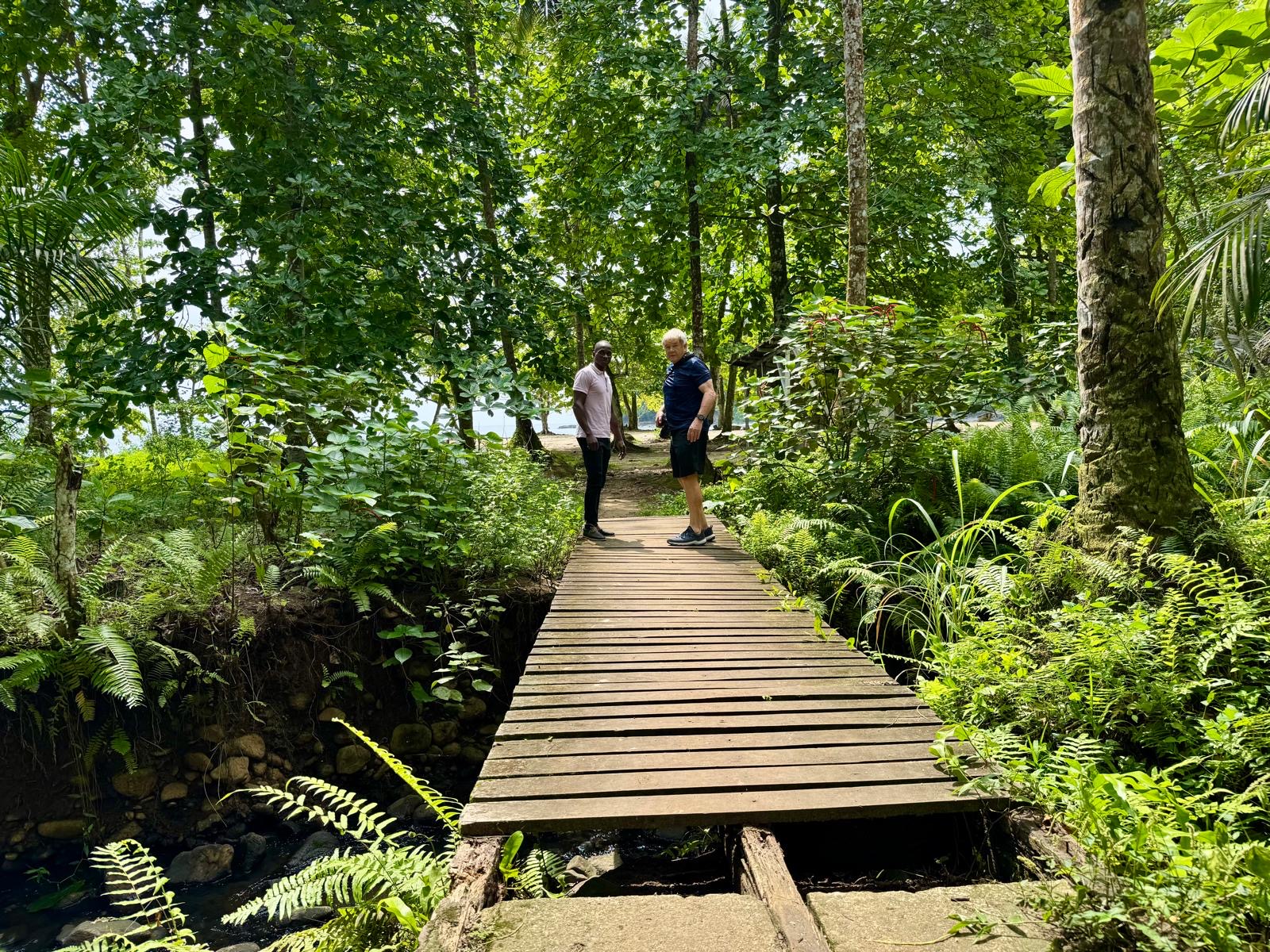


More hills, winding roads and a couple of large trucks with containers on board, constantly sounding the “get out of my way” horn, and we stopped to view the volcanic plug in the distance. Unfortunately the top part was surrounded in cloud. The view was across a valley covered in jungle with a nice river running through it.




Finally we turned off and headed down a cobbled road, with houses spaced out along the way, to a stop where we dismounted and headed down a track to look at this magnificent waterfall the tour company had told us of. Well I’ll be buggered, it must have shrunk over the last few weeks – got wider and shorter I suppose. But anyway we looked at it from some boulders while a guy took a bath in the river and a woman scrubbed away at the dirty clothes on her washboard, crying baby attached closely to her back, which she seemed almost oblivious to.


It was then time for the journey home. On the way out we had passed through a number of villages with schools. Schooling starts at 6-years here and is compulsory to the age of 14. There are six years of primary, three years of lower secondary, and three years of secondary school. School attendance at primary is so high that there are up to 80 children in each class and schooling is often split into two sessions, part of the class attending from 7:30am to 1pm and the next session from 1pm to 6pm. There is a massive shortage of teachers here. This explains why we had seen so many children around.


We think Fred thought we might be spotters for the Grand Prix as he drove like he was trying out for it, on many occasions nearly hitting one of the hundreds of school kids that were now walking down both sides of the roads and crossing the street in the towns. It got to the point where Sylvia, hanging on with both hands, yelled out to him to slow down, and I followed up with a bit of a serve. The rest of the trip became quite civilised and Sylvia was much more relaxed .
Often we saw kids packed on the back of a ute, sitting on the sides and looking quite happy as no doubt they hung on for their life. There were quite a few car wrecks on the roadside.

Arriving back in Santana, the capital, we stopped at a local artisanal chocolate-making factory. We didn’t get to look at the factory but the shop part was well set up with mouthwatering displays of chocolate cakes and chocolate ornaments. I’m not usually a cake fan because normally the nicer they look the worse they taste but I picked a nice-looking cake and it was probably the nicest piece of cake I’ve ever eaten, flavoured with passion fruit and chocolate. We had a few minutes of relaxation away from the speedy Honda.


Next we went to the Independence square near the palace, where a couple of people were dressed up in some form of costume, I think celebrating something to do with Independence Day, although that was in July. Fred couldn’t tell us so I can only guess. Back in the Honda we headed down to the other end of town to where the fort, and once slave distribution centre, was now a museum. Passing that we were dropped off back at the port where we said goodbye to Fred, who probably wondered why he didn’t get a tip.







We took a stroll back down to the fort and bought a couple of fridge magnets, then headed back and caught the tender back to the ship.
In summary I think Mr McPhersons picturesque impression had been left out in the rain before the paint had dried as most of the colour had run out of it. There were however some very nice beaches.

As we were having our tea and scones in the horizon lounge, the last tender returned from port, the passengers just dismounting before it was winched back on board, the anchors raised and we were on our way again. For the next three days we’ll be at sea, sailing down the west coast of Africa to Namibia.
